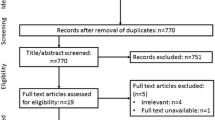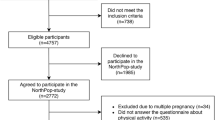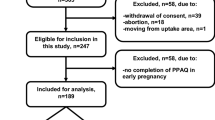Abstract
Purpose
To evaluate the association of objectively measured physical activity (PA) and sedentary behaviour before and during in vitro fertilization (IVF) with controlled ovarian stimulation (COS) and pregnancy outcomes.
Methods
This longitudinal study involved 107 infertile women undergoing IVF treatment. PA and sedentary behaviour were measured for 14 consecutive days using accelerometry as follows: (1) before IVF treatment, (2) during IVF at the implantation time, immediately after embryo transfer, and (3) after positive pregnancy test. Total screen time was assessed by questionnaires. COS results were measured as the number of oocytes and embryos obtained, and the study outcomes included positive hCG, clinical pregnancy, and live birth.
Results
Compared with baseline activity levels, women significantly reduced their PA and increased sedentary behaviour during IVF (p ≤ 0.001). Higher average PA, light PA, and ratio between breaks in every ≥ 30-min blocks of sedentary time showed positive associations, while sedentary time, number, and time accumulated in blocks of ≥ 30 min of sedentary time associated negatively with oocyte and embryo counts (all p < 0.05). Women with high total screen time during non-work days (≥ 7 h) obtained 4.7 oocytes (p = 0.005) and 2.8 embryos (p = 0.008) less in COS. PA and sedentary behaviour before and during IVF did not affect the positive hCG, clinical pregnancy, and live birth outcomes.
Conclusion
Our study results suggest that higher time spent in PA and lower time spent in sedentary behaviour before entering assisted reproduction is associated with better COS outcomes, while activity levels before and during IVF do not affect the implantation, pregnancy, and live birth outcomes.




Similar content being viewed by others
References
Macaluso M, Wright-Schnapp TJ, Chandra A, Johnson R, Satterwhite CL, Pulver A, et al. A public health focus on infertility prevention, detection, and management. Fertil Steril. 2010;93:16.e1–16.e10.
McLaren JF. Infertility evaluation. Obstet Gynecol Clin N Am. 2012;39:453–63.
Datta J, Palmer MJJ, Tanton C, Gibson LJJ, Jones KGG, Macdowall W, et al. Prevalence of infertility and help seeking among 15 000 women and men. Hum Reprod. 2016;0:1–11.
Evans J, Salamonsen LA, Winship A, Menkhorst E, Nie G, Gargett CE, et al. Fertile ground: human endometrial programming and lessons in health and disease. Nat Rev Endocrinol. 2016;12:654–67 Nature Publishing Group.
Gaskins AJ, Williams PL, Keller MG, Souter I, Hauser R, Chavarro JE, et al. Maternal physical and sedentary activities in relation to reproductive outcomes following IVF. Reprod BioMed Online. 2016;33:513–21.
Evenson KR, Hesketh KR. Studying the complex relationships between physical activity and infertility. Am J Lifestyle Med. 2016;10:232–4.
Mena GP, Mielke GI, Brown WJ. The effect of physical activity on reproductive health outcomes in young women: a systematic review and meta-analysis. Hum Reprod Update. 2019;25:542–64.
ACOG Committee Obstetric Practice. ACOG Committee opinion. Number 267, January 2002: exercise during pregnancy and the postpartum period. Obstet Gynecol. 2002;99:171–3.
Good Health Before Pregnancy: Preconception Care [Internet]. Women’s Heal. Care Physicians. 2017. p. https://www.acog.org/Patients/FAQs/Good-Health-Bef. Available from: https://www.acog.org/Patients/FAQs/Good-Health-Before-Pregnancy-Preconception-Care
Rao M, Zeng Z, Tang L. Maternal physical activity before IVF/ICSI cycles improves clinical pregnancy rate and live birth rate: a systematic review and meta-analysis. Reprod Biol Endocrinol. 2018;16:11.
Morris SN, Missmer SA, Cramer DW, Powers RD, McShane PM, Hornstein MD. Effects of lifetime exercise on the outcome of in vitro fertilization. Obstet Gynecol. 2006;108:938–45.
Ramezanzadeh F, Kazemi A, Yavari P, Nasr-Esfahani MH, Nejat S, Rahimi-Foroshani A, et al. Impact of body mass index versus physical activity and calorie intake on assisted reproduction outcomes. Eur J Obstet Gynecol Reprod Biol. 2012;163:52–6.
Evenson KR, Calhoun KC, Herring AH, Pritchard D, Wen F, Steiner AZ. Association of physical activity in the past year and immediately after in vitro fertilization on pregnancy. Fertil Steril. 2014;101:1047–1054.e5.
Ferreira RC, Halpern G, de Cássia Savio Figueira R, de Almeida Ferreira Braga DP, Iaconelli A Jr, Borges E Jr, et al. Physical activity, obesity and eating habits can influence assisted reproduction outcomes. Womens Health (Lond). 2010;6:517–24.
Kucuk M, Doymaz F, Urman B. Effect of energy expenditure and physical activity on the outcomes of assisted reproduction treatment. Reprod BioMed Online. 2010;20:274–9.
Palomba S, Falbo A, Valli B, Morini D, Villani MT, Nicoli A, et al. Physical activity before IVF and ICSI cycles in infertile obese women: an observational cohort study. Reprod BioMed Online. 2014;29:72–9.
Ekelund U, Steene-Johannessen J, Brown WJ, Fagerland MW, Owen N, Powell KE, et al. Does physical activity attenuate, or even eliminate, the detrimental association of sitting time with mortality? A harmonised meta-analysis of data from more than 1 million men and women. Lancet. 2016;388:1302–10.
Pärn T, Grau Ruiz R, Kunovac Kallak T, Ruiz JR, Davey E, Hreinsson J, et al. Physical activity, fatness, educational level and snuff consumption as determinants of semen quality: findings of the ActiART study. Reprod BioMed Online. 2015;31:108–19.
Choi L, Liu Z, Matthews CE, Buchowski MS. Validation of accelerometer Wear and nonwear time classification algorithm. Med Sci Sports Exerc. 2011;43:357–64.
Choi L, Ward SC, Schnelle JF, Buchowski MS. Assessment of Wear/nonwear time classification algorithms for triaxial accelerometer. Med Sci Sports Exerc. 2012;44:2009–16.
Migueles JH, Cadenas-Sanchez C, Ekelund U, Delisle Nyström C, Mora-Gonzalez J, Löf M, et al. Accelerometer data collection and processing criteria to assess physical activity and other outcomes: a systematic review and practical considerations. Sports Med. 2017;47:1821–45.
Freedson PS, Melanson E, Sirard J. Calibration of the computer science and applications, Inc accelerometer. Med Sci Sports Exerc. 1998;30:777–81.
Committee 2018 Physical Activity Guidelines Advisory. 2018 Physical Activity Guidelines Advisory Committee Scientific Report. Washington, DC; 2018.
Dunstan DW, Barr ELM, Healy GN, Salmon J, Shaw JE, Balkau B, et al. Television viewing time and mortality: the australian diabetes, obesity and lifestyle study (ausdiab). Circulation. 2010;121:384–91.
Hansen BH, Anderssen SA, Andersen LB, Hildebrand M, Kolle E, Steene-Johannessen J, et al. Cross-sectional associations of reallocating time between sedentary and active Behaviours on Cardiometabolic risk factors in young people: an international Children’s Accelerometry database (ICAD) analysis. Sports Med. 2018;48:2401–12.
Mekary RA, Willett WC, Hu FB, Ding EL. Isotemporal substitution paradigm for physical activity epidemiology and weight change. Am J Epidemiol. 2009;170:519–27.
Venetis CA, Tilia L, Panlilio E, Kan A. Is more better? A higher oocyte yield is independently associated with more day-3 euploid embryos after ICSI. Hum Reprod. 2018.
Tworoger SS, Missmer SA, Eliassen AH, Barbieri RL, Dowsett M, Hankinson SE. Physical activity and inactivity in relation to sex hormone, prolactin, and insulin-like growth factor concentrations in premenopausal women - exercise and premenopausal hormones. Cancer Causes Control. 2007;18:743–52.
Redman LM. Physical activity and its effects on reproduction. Reprod BioMed Online. 2006;12:579–86.
Sorensen TK, Williams MA, Lee I-M, Dashow EE, Thompson ML, Luthy DA. Recreational physical activity during Pregnancy and risk of preeclampsia. Hypertension. 2003;41:1273–80.
Gomez-Cabrera M-C, Domenech E, Viña J. Moderate exercise is an antioxidant: upregulation of antioxidant genes by training. Free Radic Biol Med. 2008;44:126–31.
Palomba S, Falbo A, Russo T, Orio F, Tolino A, Zullo F. Systemic and local effects of metformin administration in patients with polycystic ovary syndrome (PCOS): relationship to the ovulatory response. Hum Reprod. 2010;25:1005–13.
Hämmerli K, Znoj H, Barth J. The efficacy of psychological interventions for infertile patients: a meta-analysis examining mental health and pregnancy rate. Hum Reprod Update. 2009;15:279–95.
Frederiksen Y, Farver-Vestergaard I, Skovgård NG, Ingerslev HJ, Zachariae R. Efficacy of psychosocial interventions for psychological and pregnancy outcomes in infertile women and men: a systematic review and meta-analysis. BMJ Open. 2015;5:e006592.
Wise LA, Rothman KJ, Mikkelsen EM, Sørensen HT, Riis AH, Hatch EE. A prospective cohort study of physical activity and time to pregnancy. Fertil Steril. 2012;97:1136–1142.e4.
Russo LM, Whitcomb BW, Mumford SL, Hawkins M, Radin RG, Schliep KC, et al. A prospective study of physical activity and fecundability in women with a history of pregnancy loss. Hum Reprod. 2018;33:1291–8.
Hagströmer M, Bergman P, De Bourdeaudhuij I, Ortega FB, Ruiz JR, Manios Y, et al. Concurrent validity of a modified version of the international physical activity questionnaire (IPAQ-A) in European adolescents: the HELENA study. Int J Obes. 2008;32(Suppl 5):S42–8.
Owen N, Healy GN, Matthews CE, Dunstan DW. Too much sitting. Exerc Sport Sci Rev. 2010;38:105–13.
Mackenzie K, Such E, Norman P, Goyder E. The development, implementation and evaluation of interventions to reduce workplace sitting: a qualitative systematic review and evidence-based operational framework. BMC Public Health. 2018;18:833.
Ding D, Lawson KD, Kolbe-Alexander TL, Finkelstein EA, Katzmarzyk PT, van Mechelen W, et al. The economic burden of physical inactivity: a global analysis of major non-communicable diseases. Lancet. 2016;388:1311–24.
Foucaut A-M, Faure C, Julia C, Czernichow S, Levy R, Dupont C. Sedentary behavior, physical inactivity and body composition in relation to idiopathic infertility among men and women. Drevet JR, editor. PLoS One. 2019;14:e0210770.
Stoop D, Ermini B, Polyzos NP, Haentjens P, De Vos M, Verheyen G, et al. Reproductive potential of a metaphase II oocyte retrieved after ovarian stimulation: an analysis of 23 354 ICSI cycles. Hum Reprod. 2012;27:2030–5.
Grøntved A, Hu FB. Television viewing and risk of type 2 diabetes, cardiovascular disease, and all-cause mortality: a meta-analysis. JAMA. 2011;305:2448–55.
Sun J-W, Zhao L-G, Yang Y, Ma X, Wang Y-Y, Xiang Y-B. Association between television viewing time and all-cause mortality: a meta-analysis of cohort studies. Am J Epidemiol. 2015;182:908–16.
Gaskins AJ, Mendiola J, Afeiche M, Jørgensen N, Swan SH, Chavarro JE. Physical activity and television watching in relation to semen quality in young men. Br J Sports Med. 2015;49:265–70.
Sharif K, Afnan M, Lashen H, Elgendy M, Morgan C, Sinclair L. Is bed rest following embryo transfer necessary? Fertil Steril. 1998;69:478–81.
Purcell KJ, Schembri M, Telles TL, Fujimoto VY, Cedars MI. Bed rest after embryo transfer: a randomized controlled trial. Fertil Steril. 2007;87:1322–6.
Lambers MJ, Lambalk CB, Schats R, Hompes PGA. Ultrasonographic evidence that bedrest after embryo transfer is useless. Gynecol Obstet Investig. 2009;68:122–6.
Su TJ, Chen YC, Hung YT, Yang YS. Comparative study of daily activities of pregnant and non-pregnant women after in vitro fertilization and embryo transfer. J Formos Med Assoc. 2001;100:262–8.
Bar-Hava I, Kerner R, Yoeli R, Ashkenazi J, Shalev Y, Orvieto R. Immediate ambulation after embryo transfer: a prospective study. Fertil Steril. 2005;83:594–7.
Acknowledgements
We thank infertile women for participating in the study.
Funding
The study was supported by Estonian Ministry of Education and Research (grant IUT34-16); Enterprise Estonia (grant EU48695); the European Commission Horizon 2020 research and innovation program under grant agreement 692065 project WIDENLIFE); MSCA-RISE-2015 project MOMENDO (grant no 691058), and University of Tartu base funding; Spanish Ministry of Economy, Industry and Competitiveness (MINECO) and European Regional Development Fund (FEDER): grants RYC-2016-21199 and ENDORE SAF2017-87526-R; Programa Operativo FEDER Andalucía (B-CTS-500-UGR18) and by the University of Granada Plan Propio de Investigación 2016 -Excellence actions: Unit of Excellence on Exercise and Health (UCEES) - and Plan Propio de Investigación 2018 - Programa Contratos-Puente, and the Junta de Andalucía, Consejería de Conocimiento, Investigación y Universidades, European Regional Development Funds (ref. SOMM17/6107/UGR); and Karolinska Institutet Foundation grant (Ref: 2011FoBi1184).
Author information
Authors and Affiliations
Contributions
All authors contributed to the study design, execution, and interpretation of the study. DS, EM, MN, JM, AE, AS, AS, and AS were responsible for the data collection; FBO and JHM were responsible for the data analysis; and DS and SA drafted the first version of the manuscript. All authors revised critically the manuscript and approved the final version of the manuscript.
Corresponding author
Ethics declarations
Ethical approval
The study was approved by the Research Ethics Committee of the University of Tartu.
Statement of informed consent
Written informed consent was obtained from all subjects before their participation.
Additional information
Publisher’s note
Springer Nature remains neutral with regard to jurisdictional claims in published maps and institutional affiliations.
Key message
Higher levels of light physical activity and shorter sedentary behaviour and screen-watching times before entering infertility treatment associate with better ovarian stimulation outcomes under IVF treatment protocols.
Electronic supplementary material
ESM 1
(DOCX 21 kb).
Rights and permissions
About this article
Cite this article
Sõritsa, D., Mäestu, E., Nuut, M. et al. Maternal physical activity and sedentary behaviour before and during in vitro fertilization treatment: a longitudinal study exploring the associations with controlled ovarian stimulation and pregnancy outcomes. J Assist Reprod Genet 37, 1869–1881 (2020). https://doi.org/10.1007/s10815-020-01864-w
Received:
Accepted:
Published:
Issue Date:
DOI: https://doi.org/10.1007/s10815-020-01864-w




